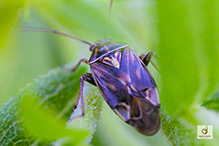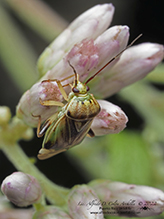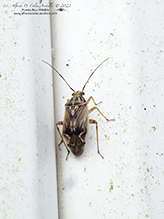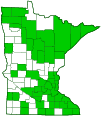tarnished plant bug
(Lygus lineolaris)
Conservation • Description • Habitat • Ecology • Distribution • Taxonomy
|
|
||||||||||||||
Description |
Tarnished plant bug is a very common, native, plant bug. It occurs throughout the United States, southern Canada, and Mexico. It is found in fields, meadows, gardens, parks, woodlands, agricultural fields, orchards, nurseries, and greenhouses. Tarnished plant bugs have been recorded feeding on at least 385 species of plants. They are a serious economic pest of many agricultural crops, including apples, carrots, cherries, cotton, lima beans, seed alfalfa, snap beans, soybeans, peaches, pears, strawberries, and tomatoes. They are also an important pest of conifer seedlings in nurseries. Other crops they attack include artichoke, asparagus, broccoli, cabbage, celery, chard, coriander, corn, cowpea, cucumber, eggplant, endive, escarole, fava bean, fennel, horseradish, lettuce, mustard, onion, parsnip, parsley, pea, pepper, potato, radish, spinach, squash, sweet potato, turnip, and watermelon. In greenhouses, they attack asters, chrysanthemums, dahlias, impatiens, and marigolds. In nurseries they attack loblolly pine, white spruce, lodgepole pine, Douglas-fir, and western larch. Adult males are 3⁄16″ to ¼″ (4.90 to 5.95 mm) in length and ⅛″ (2.38 to 3.01 mm) wide. Females are 3⁄16″ to ¼″ (5.25 to 5.95 mm) in length and ⅛″ (2.52 to 3.01 mm) wide. The body is oval and soft. The coloration is variable. There are three or more generations per year between May and October. Summer adults tend to be light colored, and overwintering adults, the last generation, are dark colored. The body is yellow (pale) with dark reddish brown to black (dark) markings. It is covered with long, reclining, yellow hairs. The head is slanted forward and yellowish brown. The compound eyes are large. There are no simple eyes (ocelli). There is a prominent raised ridge (carina) between the eyes. The upper part of the face (frons) is smooth, with no grooves or ridges. A dark longitudinal stripe in the middle (median) extends from the top of the frons to the bottom on the plate above the upper lip (clypeus). There is an oblique, dark stripe on the frons on each side of the middle (submedian). The cheeks (genae) are black. The mouth parts are optimized for piercing and sucking. They take the form of a long, 4-segmented beak. When not used, the beak extends from the front of the head, along the underside of the body between the legs, to or slightly behind the tip of the first segment (coxa) of the hind legs. The antennae are slender, thread-like, and short. They have 4 segments. The second segment is shorter than the width of the head. The exoskeletal plate covering the first segment of the thorax (pronotum) is widest at the base and much narrower behind the head. It has a distinct, exposed collar in front, and the rear angles are rounded. There is a small, rounded tubercle (callus) at the front outer angle on each side of the pronotum behind the collar. The pronotum is pale to reddish brown with broad, black, longitudinal stripes, black near the callus, black at the rear corners, blackish at the rear margin, and a thin pale longitudinal line in the middle (middorsal). The surface of the pronotum is densely pitted (punctate) with coarse, dark punctures. The exoskeletal plate between the wing bases (scutellum) is large and triangular. It is dark on the sides and at the base with a distinct, large, pale, Y-shaped or heart-shaped marking. There are two pairs of wings. The front wings (hemelytra) are longer than the hind wings and a little longer than the body. They are held flat over the body when at rest. On light-colored individuals, they are pale with dark streaks and a variable amount of dark shading. On dark-colored individuals, they are dark with pale streaks to almost entirely dark. The surface is densely punctate. The hemelytra have a thickened, leathery part at the base and a thin membranous part at the tip with a clear dividing line between the two. The thickened part is comprised of the narrow area (clavus) behind the scutellum when the wings are closed, and the broad marginal area (corium). At the end of the corium there is a small but distinct triangular area (cuneus). The corium always has a short, narrow, pale stripe on the inner margin at its widest point, which is near the tip of the membrane. The cuneus is pale. It has a dark, crescent-shaped band near the top, and the tip is black. The membrane is dark. The veins are pale and moderately to faintly contrasting with the dark membrane. The hind wings are thin and membranous. The legs are relatively long. |
Size |
Female total length: 3⁄16″ to ¼″ (5.25 to 5.95 mm) Male total length: 3⁄16″ to ¼″ (4.90 to 5.95 mm) |
Similar Species |
Habitat |
|
Ecology |
Season |
Three to six generations per year: May through October |
Behavior |
|
Life Cycle |
Adults overwinter |
Nymph Hosts |
|
Adult Food |
At least 385 species of plants |
Distribution |
||
|
Sources |
|
| 1/28/2025 | ||
Occurrence |
||
Very common |
||
Taxonomy |
|
Order |
Hemiptera (True bugs, Hoppers, Aphids, and Allies) |
Suborder |
Heteroptera (True Bugs) |
Infraorder |
Cimicomorpha |
Superfamily |
Miroidea |
Family |
|
Subfamily |
Mirinae |
Tribe |
Mirini |
Genus |
Lygus (lygus bugs) |
Subordinate Taxa |
|
|
|
Synonyms |
|
Capsus flavonotatus Capsus lineolaris Capsus oblineatus Capsus strigulatus Liocoris lineolaris Lygus flavonotatus Lygus oblineatus Lygus pratensis ssp. rubidus Lygus rubidus Lygus strigulatus |
|
Common Names |
|
North American tarnished plant bug tarnished plant bug
iNaturalist uses the common name “North American tarnished plant bug,” apparently to distinguish the species from Western tarnished plant bug (Lygus hesperus) and European tarnished plant bug (Lygus hesperus). In this they appear unique. |
|
Glossary
Carina
An elevated keel or ridge.
Clypeus
On insects, a hardened plate on the face above the upper lip (labrum).
Coxa
The first (most proximal) segment of the legs of most arthropods, including all insects, spiders, and crustaceans, and most arachnids. It attaches the leg to the body and connects to the trochanter. Plural: coxae.
Frons
The upper front part of an insect’s face, roughly corresponding to the forehead.
Gena
In insects: The area between the compound eye and the mandible; the cheek. In birds: The area between the the angle of the jaw and the bill; the feathered side (outside) of the under mandible. Plural: genae.
Hemelytron
The forewing of true bugs (order Hemiptera), thickened at the base and membranous at the tip. Plural: hemelytra.
Ocellus
Simple eye; an eye with a single lens. Plural: ocelli.
Pronotum
The exoskeletal plate on the upper side of the first segment of the thorax of an insect.
Punctate
Dotted with pits (punctures), translucent sunken glands, or colored spots of pigment.
Scutellum
The exoskeletal plate covering the rearward (posterior) part of the middle segment of the thorax in some insects. In Coleoptera, Hemiptera, and Homoptera, the dorsal, often triangular plate behind the pronotum and between the bases of the front wings. In Diptera, the exoskeletal plate between the abdomen and the thorax.
Tubercle
On plants and animals: a small, rounded, raised projection on the surface. On insects and spiders: a low, small, usually rounded, knob-like projection. On slugs: raised areas of skin between grooves covering the body.
Visitor Photos |
||
Share your photo of this insect. |
||
This button not working for you? |
||
Mike Poeppe |
 |
Alfredo Colon |
||
 |
 |
|
 |
||
MinnesotaSeasons.com Photos |
||
|
||
|
||

Visitor Videos |
||
Share your video of this insect. |
||
This button not working for you? |
||
|
Other Videos |
||
Lygus lineolaris |
About
Jul 8, 2021 |

Visitor Sightings |
||
Report a sighting of this insect. |
||
This button not working for you? |
||
Mike Poeppe |
Location: Houston, MN |
 |
Alfredo Colon |
Location: Albany, NY |
 |
Alfredo Colon |
Location: Albany, NY |
 |
Alfredo Colon |
Location: Albany, NY |
 |
MinnesotaSeasons.com Sightings |
||
|

|
Created: 1/28/2025 Last Updated: © MinnesotaSeasons.com. All rights reserved. |


